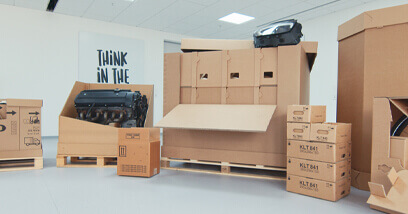

Industrial packaging must be strong, which is why heavy-duty corrugated board doesn’t immediately spring to mind as the perfect solution. But for many packaging challenges, it can save time, money and resources.
Automotive components, chemicals, DIY products, household appliances, sporting goods…the list of industries and manufacturers that need to package and ship their products reliably and efficiently is virtually endless. This is not by any means a trivial challenge, especially when import regulations or other issues in production and logistics or distribution bring additional complexity. Such issues usually include shipping, storage, safety, or the simple matter of handling of packaging on site. At the same time, companies need to consider their own CO2 footprint and overall sustainability, which is an area many companies struggle with.
With those challenges in mind, a high-performance and reliable alternative to wood or metal is heavy-duty corrugated board, as industrial packaging for heavy loads. Weighing up to 80% less than wood or metal industrial packaging, it undergoes a broad range of tests during development, oriented to a broad range of anticipated conditions: drop tests in the lab, climate chambers, and comprehensive shipping simulations for a wide range of conditions. Most heavy-duty corrugated board solutions are better than more rigid types of packaging in absorbing shocks and vibration during transportation. And heavy-duty corrugated board can withstand demanding conditions such as heat or humidity. Especially when shipped by sea, contents are exposed to high ambient humidity and high condensation, often for several weeks. All of Mondi’s heavy-duty corrugated board grades are therefore bonded based on wet-strength parameters and are made using high-quality papers for durability across different climatic regions.
With heavy-duty corrugated board, various import restrictions do not apply–import restrictions relating to wooden containers, for example, which can sometimes be a source of problems. And since corrugated board is a recyclable single-journey solution, it does not have to be shipped all the way back empty, which is often the case with wooden or metal packaging. Moreover, it is easy to fold and compact on site in preparation for recycling. Thanks to corrugated board’s current status as the most frequently recycled packaging material, Europe and other regions have extensive, advanced recycling infrastructure for recycling it. Heavy-duty corrugated board is also designed to maximise the efficient utilisation of shipping and storage space.
In a recent case study, the corrugated solution developed by Mondi for brake boosters for Volvo Cars enabled 18 units to be packed instead of the previous twelve, with the same packing volume, i.e. a 50% increase in packing density using almost the same amount of material. Overall, based on the total number of components shipped, a 33% reduction in the amount of raw materials and the amount of shipping and storage space required was achieved.
Important facts
- Heavy-duty corrugated board packaging is a serious alternative to other types of industrial packaging for heavy loads which weighs up to 80% less than wood or metal industrial packaging;
- Packaging made of heavy-duty corrugated board is foldable, thus offers an efficient utilisation of space;
- For the chemicals industry: containers made of heavy-duty corrugated board for granulates and powders.






